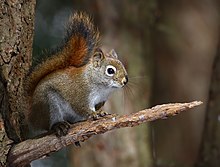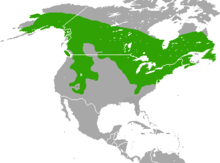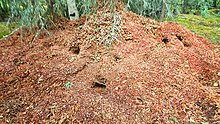American red squirrel
| American red squirrel | |
|---|---|

| |
| At Cap Tourmente National Wildlife Area, Quebec | |
| Scientific classification | |
| Domain: | Eukaryota |
| Kingdom: | Animalia |
| Phylum: | Chordata |
| Class: | Mammalia |
| Order: | Rodentia |
| Family: | Sciuridae |
| Genus: | Tamiasciurus |
| Species: | T. hudsonicus
|
| Binomial name | |
| Tamiasciurus hudsonicus (Erxleben, 1777)
| |
| Subspecies[3] | |
| |

| |
| Distribution (including T. fremonti) | |
The American red squirrel (Tamiasciurus hudsonicus) is one of three
The squirrel has been expanding its range into hardwood forests.[4]
Taxonomy
American red squirrels should not be confused with Eurasian red squirrels (
The southwestern red squirrel (T. fremonti) was long considered conspecific with T. hudsonicus, but a 2016 phylogenetic study found it to be a distinct species.[8]
Description
Red squirrels can be easily distinguished from other North American tree squirrels by their smaller size, 28–35 cm (11–14 in) total length (including tail), territorial behavior, and reddish fur with a white venter (underbelly).[7] Red squirrels are somewhat larger than chipmunks.
The Douglas squirrel is morphologically similar to the American red squirrels, but has a rust-colored venter and is restricted to the southwestern coast of British Columbia and in the Pacific Northwest of the United States. The ranges of the American red squirrel and the Douglas squirrel overlap in southern British Columbia, northwestern Washington and eastern Oregon.[9]
Distribution

American red squirrels are widely distributed across the North American continent. Their range includes: most of Canada, excluding northern areas with no tree cover, the southern half of Alberta and the southwestern coast of British Columbia; the southern half of Alaska; the Rocky Mountains area of the United States, and northern half of the eastern United States.[7][10] American red squirrels are abundant and not of conservation concern throughout much of their range. American red squirrels were introduced on Newfoundland and have lived there in abundance for decades.[11] However, an isolated population of red squirrels in Arizona has experienced considerable declines in population size. In 1987, this portion of the population was listed as an endangered species.[12]

Behavior
Feeding


American red squirrels are primarily
American red squirrels eat a variety of mushroom species, including some that are deadly to humans.[17]
Reproduction
American red squirrels are spontaneous
Nests are most commonly constructed of grass in the branches of trees. Nests are also excavated from witches' broom – abnormally dense vegetative growth resulting from a rust disease – or cavities in the trunks of spruce, poplar, and walnut trees. American red squirrels rarely nest below ground. Each individual squirrel has several nests within its territory, and females with young move them between nests. Some behavior has been reported within human dwellings using insulation as nest material.
A three-year study of a population of red squirrels in southwest Yukon reported female red squirrels showed high levels of multiple-male mating and would even mate with males with similar genetic relatedness. The relatedness of parents had no effect on the neonatal mass and growth rate of their offspring, nor did it affect the survival rate of offspring to one year of age.[21]
Sociality
Red squirrels are highly territorial and asocial with very few non-reproductive physical interactions (0.6% of all recorded behaviours in one 19-year study).[22] The majority of physical interactions are in male-female matings and between females and their offspring before the offspring disperse to their own territories (see Dispersal and survival). The non-reproductive physical interactions recorded were all instances of chasing an intruder from a territory.[22]
Dispersal and survival

If juvenile American red squirrels are to survive their first winter, they must acquire a territory and midden. They can acquire a territory by competing for a vacant territory, creating a new territory or by receiving all or part of a territory from their mothers. This somewhat rare (15% of litters) female behavior is referred to as breeding dispersal or bequeathal, and is a form of maternal investment in offspring.[23] The prevalence of this behavior is related to the abundance of food resources and the age of the mother. In some cases, females will acquire additional middens prior to reproduction, which they later bequeath to their offspring.[24] Offspring that do not receive a midden from their mother typically settle within 150 m (3 territory diameters) of their natal territory.[23] Observations suggest that male red squirrels have environmentally induced, alternative reproductive strategies that result in higher incidences of sexually selected infanticide in years when food is plentiful.[25]
American red squirrels experience severe early mortality (on average only 22% survive to one year of age). The survival probability, however, increases to age three, when it begins to decrease again. Females that survive to one year of age have a life expectancy of 3.5 years and a maximum lifespan of 8 years.[26] Increased maternal attention is correlated with increased offspring growth rate and higher lifetime reproductive success.[27]
Chief predators include Canada lynx (Lynx canadensis), bobcat (Lynx rufus), coyote (Canis latrans), great horned owl (Bubo virginianus), northern goshawk (Accipiter gentilis), red-tailed hawk (Buteo jamaicensis), American crow (Corvus brachyrynchos), American marten (Martes americana), pacific marten (Martes caurina), red fox (Vulpes vulpes), gray fox (Urocyon cinereoargenteus), wolf (Canis lupus), and weasel (Mustela sp.).[28]
References
- . Retrieved 19 February 2022.
- ^ "Tamiasciurus hudsonicus". NatureServe Explorer. Retrieved 17 April 2024.
- OCLC 26158608.
- .
- ^ Woods, S.E.J. (1980). The Squirrels of Canada. National Museums of Canada.
- S2CID 40366357.
- ^ S2CID 253900287. Archived from the original(PDF) on 2016-03-04. Retrieved 2017-01-06.
- PMID 27083861.
- ISBN 9781588341006.)
{{cite book}}: CS1 maint: multiple names: authors list (link - .
- ^ Payne, Neil F. (1976). "Red Squirrel Introduction to Newfoundland". Canadian Field-Naturalist. 90: 60–64.
- ^ Arizona Game and Fish Department. (2003). Tamiasciurus hudsonicus grahamensis. Archived 2010-12-30 at the Wayback Machine Heritage Data Management System, Arizona Game and Fish Department, Phoenix, AZ.
- doi:10.1139/z03-096.
- ^ Baheyeldin, Khalid (2020-09-05). "Red Squirrel Harvesting and Storing White Spruce Cones". YouTube. Archived from the original on 2021-11-07.
- PMID 21236924. Archived from the original(PDF) on 2010-05-25. Retrieved 2017-01-06.
- ^ Nienstaedt, Hans; Zasada, John C. (1990). "Picea glauca". In Burns, Russell M.; Honkala, Barbara H. (eds.). Conifers. Silvics of North America. Vol. 1. Washington, D.C.: United States Forest Service (USFS), United States Department of Agriculture (USDA) – via Southern Research Station.
- ISBN 978-0-89577-102-5.
- JSTOR 1948465.
- doi:10.1139/z70-079.
- JSTOR 1380818.
- ^ When It Comes to Female Red Squirrels, It Seems Any Male Will Do. Newswise (20 June 2008).
- ^ S2CID 205305747.
- ^ JSTOR 177210.
- PMID 11416912.
- PMID 29543323.
- S2CID 86378466.
- S2CID 219176132.
- ^ Rubin, Catherine. "Tamiasciurus hudsonicus (red squirrel)". Animal Diversity Web. Retrieved 2021-06-26.
External links
- Density and distribution old-growth forest, University of Alaska Fairbanks, Moriz Steiner, Falk Huettmann
- Kluane Red Squirrel Project webpage – Kluane National Park and Reserve, Yukon
- Article on the American red squirrel – National Museum of Natural History
- Mount Graham Red Squirrel Research – School of Natural Resources and the Environment, University of Arizona
- American red squirrel, Fletcher Wildlife Garden


